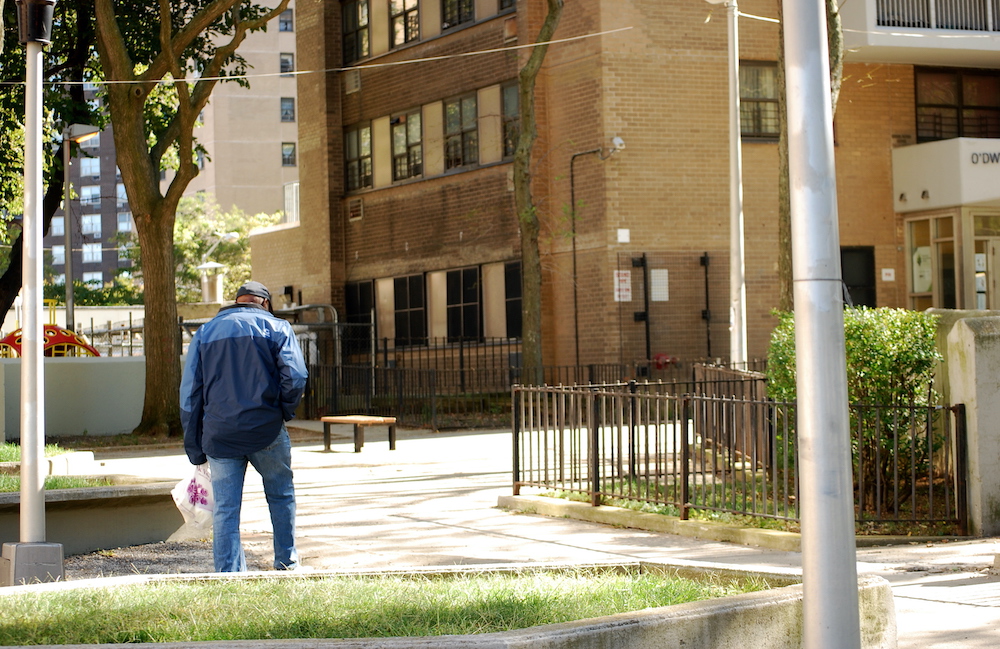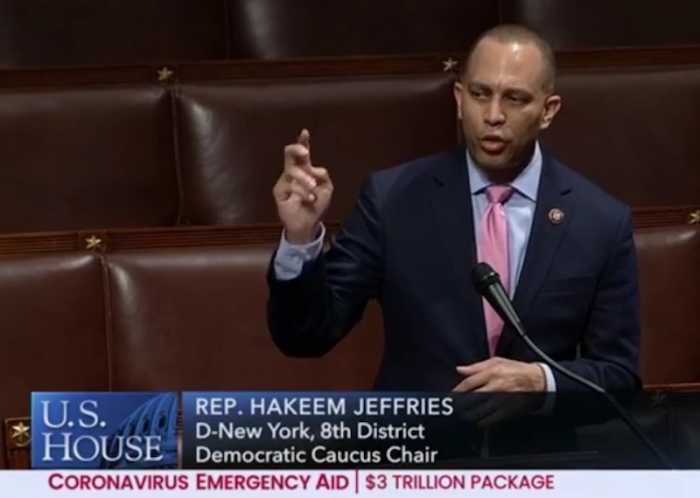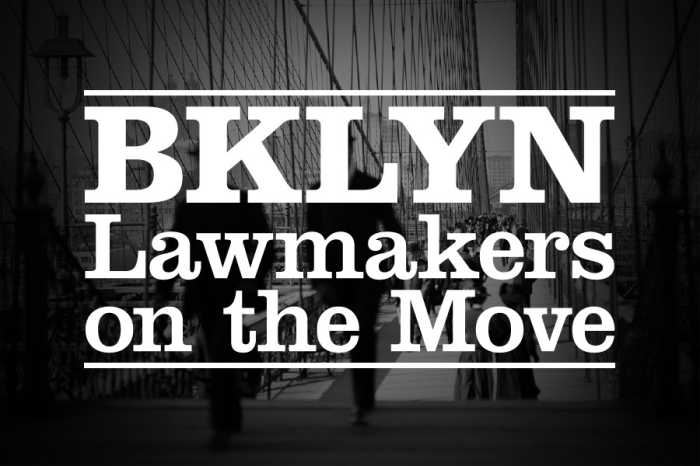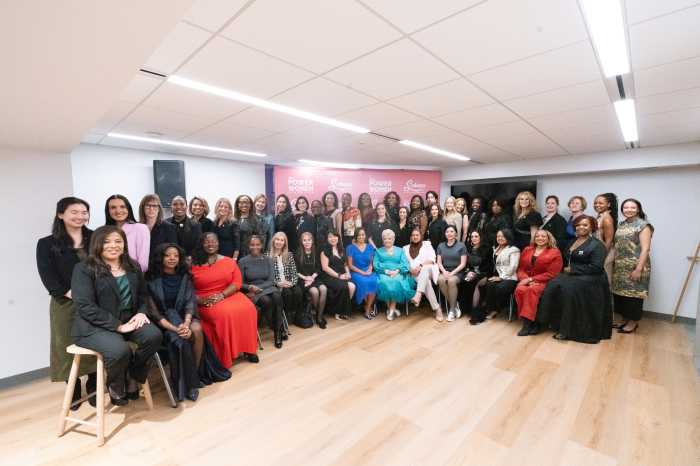Residents and Tenant Association Presidents of New York City Housing Authority (NYCHA) O’Dwyer Gardens Houses, and Surfside Gardens in Coney Island, joined by Community Advocate Tony Herbert and Assemblymember Mathylde Frontus (D-Coney Island, Brighton Beach, Bay Ridge,), at 2951 W 33rd Street on Saturday, October 17, came together Saturday at 2951 W 33rd Street to call for NYCHA and Federal Emergency Management Agency (FEMA) funds allocated to fix long overdue Hurricane Sandy-related damage to the resident’s lobbies, grounds, playgrounds, lighting fixtures, and general infrastructure.
“This project for Sandy recovery has been going on too long,” said Surfside Gardens Tenant Association President Robert Santiago. Among the list of demands are waterproofing from the foundation up to the first floor, which was previously underwater; an electrical power room built in an adjacent building not inside of a second-floor apartment; and playgrounds and brickwork completely replaced and not just painted over, said Santiago.
“You did not spend $20 million fixing the first-floor apartments which are falling apart and full of mold already. And you did not spend $20 million on these rooms. Okay, let’s get it straight. The funding for FEMA that was given to housing for this project should go the right way,” said Santiago, who had been corresponding with NYCHA representatives via email on how much had been spent at Surfside in September prior to the conference.

According to the email response, there is a “total amount slated for Surfside, O’Dwyer, and Site 8 for remaining work” and the current contract is “$186,800,000.” The aforementioned $20 million was spent on “replacement of electrical feeders,” “the installation of new underground utilities,” and “roof replacement work” in 2019.
The community members seem most upset that they have not been kept aware of what was happening with the money since they can’t see any obvious changes or repairs being made to their damaged building’s lobbies and grounds, and it has been a number of years.



“NYCHA, keep your word,” said Frontus, who was present at the conference. She said she reached out to NYCHA after Smalls contacted her, and immediately spoke to them the next day. She said they “in a matter of days” were going to come out and answer for this oversight in repairs. “They said they’re going to provide answers to the elected officials and tenant presidents because we deserve that,” said Frontus.
City Councilmember Mark Treyger (D-Bensonhurst, Coney Island, Gravesend, Sea Gate), who said that he had not been invited to the conference and therefore was not there, gave a brief breakdown of the situation with NYCHA and FEMA.
Treyger said his office and U.S Rep. Hakeem Jeffries (D-n Central Brooklyn, Coney Island) “fought like hell” to get the issue even on the radar. “When I took office in January 2014 not a dime, not one dime was committed to any of the NYCHA developments in Coney Island and all of the impacted reports from Hurricane Sandy,” said Treyger.
He said in 2015 the agreement was for a scope of work that included new roofs, backup generators, infrastructure that was flooded and needed to be replaced, resilient boilers, new lobbies, doors, and cameras.
“It’s my understanding that NYCHA is claiming significant ‘cost overruns’ in the work, and that is what I was told as of even last week,” said Treyger. “Part of the issue here is that NYCHA with all of its issues and problems is an underfunded entity, authority. They need more help. The majority of its budget comes from New York City.”
He agreed that the community is rightfully upset about the scope of the work which needs clarity, that the project is moving too slowly, and that better communication and full transparency is needed.
FEMA is only responsible for “Sandy-related work” and technically funds couldn’t be applied to the general ailing structure of the building, which was made worse by the hurricane. Treyger said from his understanding this is what supposedly ate into the budget to get work done. “NYCHA’s still on the hook to get this done, but they’re claiming the FEMA money falls short,” said Treyger.
However, FEMA said, in response to KCP inquiries, they approved “Project Worksheet 4668” on December 18, 2015, for $95,919,143.46 to address Hurricane Sandy damage and mitigation work at O’Dwyer Gardens, and they also approved a section of the project, which provides “NYCHA with increased flexibility for utilizing project funding based on its own priorities.”
“Congressman Jeffries was not invited to Saturday’s event, nor was the office made aware of it in advance. Throughout October, our office has been in contact with the Tenant Association President for O’Dwyer Gardens about the overall state of the development and Sandy Recovery renovations and repairs. The office remains in contact with them and is scheduling a meeting with NYCHA about Sandy recovery and resiliency funds due to be spent before 2022,” said a member of Jeffries’ staff.
In response to KCP, NYCHA Spokesperson Rochel Leah Goldblatt, had this to say, “As part of NYCHA’s Sandy Recovery, the Authority is improving structural resiliency and infrastructure protection at the properties affected by Superstorm Sandy. NYCHA is using $275 million in FEMA funding for upgrades in heating, back-up power generators, building floodproofing, and safety infrastructure at O’Dwyer Gardens, Surfside Gardens and Coney Island (Site 8).”
Goldblatt said that construction repairs began in 2017 and are slated to be completed by the end of 2022. “We have already completed roof replacements at all three developments and at O’Dwyer NYCHA has additionally completed façade repairs at all the balconies and on the brickwork,” said Goldblatt.
But while Superstorm Sandy happened eight years ago, and NYCHA was given a nearly blank check from FEMA for Sandy-related repairs, these local residents remain frustrated at the lack of Sandy-related work done at their developments.
At the press conference, KCP noted that out in front of the O’Dwyer main building there was clearly sinking pavement and cement, potholes, mold on playgrounds and pillars present, lampposts and fixtures duct-taped together, and improperly working security doors.
“I’ve seen the work that my grandma has done with many of the individuals in this community. My elders that I have learned from. I’m 34 years old now, born and raised in Coney Island. And I’m still here and it hurts walking around my neighborhood these days,” said Ciara Shields, a life-long resident of O’Dwyer, who’s grandmother was also a tenant association president for many years.
“Why? Because I look at my neighborhood and I look at the people that have raised me as a youth. But at the same time as I look out on the outskirts. I see a lot of development happening. I see a lot of private real estate going up in my neighborhood, around my neighborhood but yet I don’t see the improvements happening inside my neighborhood. The buildings are falling apart.”









